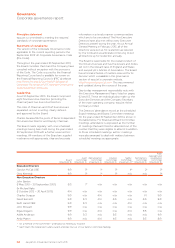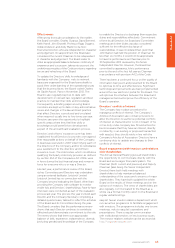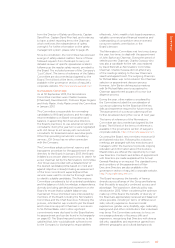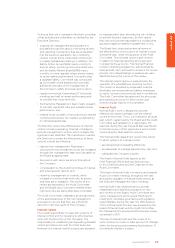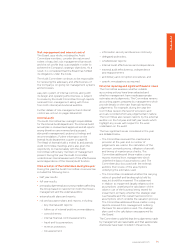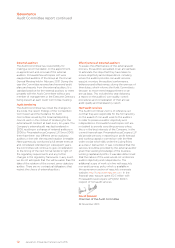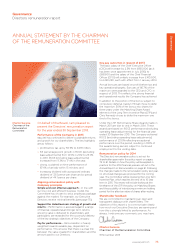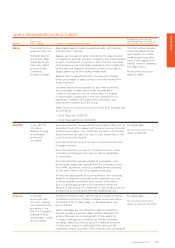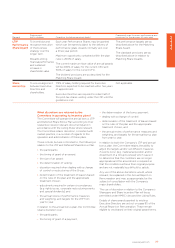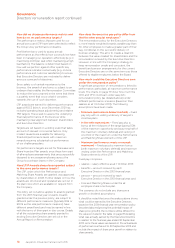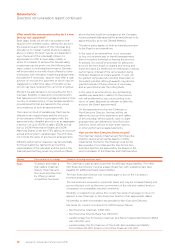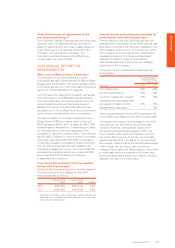EasyJet 2013 Annual Report Download - page 73
Download and view the complete annual report
Please find page 73 of the 2013 EasyJet annual report below. You can navigate through the pages in the report by either clicking on the pages listed below, or by using the keyword search tool below to find specific information within the annual report.
www.easyJet.com 71
Governance
Risk management and internal control
The Board, as a whole, including the Audit
Committee members, consider the nature and
extent of easyJet’s risk management framework
and the risk profile that is acceptable in order to
achieve the Company’s strategic objectives. As a
result, it is considered that the Board has fulfilled
its obligations under the Code.
The Audit Committee continues to be responsible
for reviewing the adequacy and effectiveness of
the Company’s on-going risk management systems
and processes.
easyJet’s system of internal controls, along with
its design and operating effectiveness, is subject
to review by the Audit Committee through reports
received from management, along with those
from both internal and external auditors.
Further details of risk management and internal
control are set out on pages 68 and 69.
Internal audit
The Audit Committee has oversight responsibilities
for the Internal Audit department. The Internal Audit
annual plan is reviewed and approved and all reports
arising therefrom are reviewed and assessed,
along with management’s actions to findings and
recommendations. Further information on the
Internal Audit department is given on page 69.
The Head of Internal Audit is invited to and attends
Audit Committee meetings and is also given the
opportunity to meet privately with the Audit
Committee without any members of management
present. During the year the Audit Committee
undertook an internal assessment of the effectiveness
and independence of the Internal Audit function.
Main activities of the Committee during the year
During the year the Audit Committee’s business has
included the following items:
• half year results;
• full year results;
• principal judgemental accounting matters affecting
the Group based on reports from both the Group’s
management and the external auditors;
• external audit plans and reports;
• risk and assurance plans and reports, including:
– key internal audit reports;
– follow up of internal audit recommendations;
– control themes;
– internal financial control assessments;
– fraud and loss prevention;
– revenue protection;
– risk assessment;
• information security and business continuity;
• delegated authorities;
• whistleblower reports;
• Internal Audit effectiveness and independence;
• external audit effectiveness, independence
and reappointment;
• anti-bribery and corruption procedures; and
• specific investigations as required.
Financial reporting and significant financial issues
The Committee assesses whether suitable
accounting policies have been adopted and
whether management have made appropriate
estimates and judgements. The Committee reviews
accounting papers prepared by management which
provide details on the main financial reporting
judgements. For example, during the year the
Committee reviews the level of provisions and
accruals recorded which are judgemental in nature.
The Committee also reviews reports by the external
auditors on the full year and half year results which
highlight any issues with respect to the work
undertaken on the audit.
The two significant issues considered in the year
are detailed below:
• The Committee reviewed the maintenance
provision at the year end. A number of
judgements are used in the calculation of the
provision, primarily pricing, utilisation of aircraft
and timing of maintenance checks. The
Committee addressed these matters using
reports received from management which
underlie the basis of assumptions used. The
Committee also discussed with the external
auditors their review of the assumptions
underlying the estimates used.
• The Committee considered whether the carrying
value of goodwill and landing rights held by
easyJet should be impaired. The judgement
in relation to impairment largely relates to the
assumptions underlying the calculation of the
value in use of the business being tested for
impairment, primarily whether the strategic plan
is achievable and the overall macroeconomic
assumptions which underlie the valuation process.
The Committee addressed these matters using
reports received from management outlining
the basis for assumptions used. The strategic
plan used in the calculation was approved by
the Board.
The Committee is satisfied that the judgements made
by management are reasonable, and that appropriate
disclosures have been included in the accounts.





